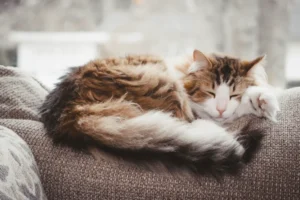Cats are known for their mysterious behavior, often leaving their owners wondering why they hide and meow. Understanding the reasons behind these actions can help cat owners provide better care for their feline companions. In this blog post, we will explore the common motives behind why cats exhibit these behaviors.
The Instinctual Nature of Cats
Cats have a rich history of evolutionary instincts that drive their behaviors, including hiding and meowing. In the wild, cats are solitary hunters, and their natural instinct is to seek out hiding spots to stay safe from potential predators. This instinct carries over into domesticated cats, who often hide in quiet, secluded areas in the home to feel secure and protected.
Meowing, on the other hand, is a form of communication that has evolved over time . While adult cats typically do not meow at each other, they use this vocalization to communicate with humans. Cats may meow to seek attention, express discomfort, or signal hunger. Each meow has a specific purpose, and it’s essential for cat owners to pay attention to the context in which their feline friends meow to understand their needs better.
Communication Through Meowing
Cats are masters of communication, and meowing plays a crucial role in how they interact with their human companions. When a cat meows, it’s their way of trying to tell you something. It could be a simple greeting, a request for food, or a plea for attention. Understanding the various types of meows can help decipher what your cat is trying to communicate.
Here are some common types of meows and their meanings: 1. Short, sharp meows: often used to say hello or get your attention. 2. Long, plaintive meows: may indicate hunger or a desire for something specific. 3. Prolonged, loud meows: could signal distress or discomfort.
So, the next time your cat meows, take a moment to listen and observe their body language to determine what they might be trying to tell you. Communication is key to fostering a strong bond with your feline companion.
For more in-depth insights into cat behavior and communication, check out this informative resource from the American Association of Feline Practitioners: Understanding Cat Behavior.
Seeking Safety and Security
When your feline friend decides to disappear out of sight, it may not be running away from you but seeking safety and security. Cats are natural-born hunters and are wired to be cautious in new or unfamiliar environments. So, if your furry pal ducks under the bed or behind the couch, don’t take it personally. Instead, create a safe space for your cat where it feels secure, like a cozy corner with its favorite blanket or toy. This will help reduce stress and make your kitty feel more comfortable in its surroundings.
Loneliness and Boredom
Have you ever wondered why your cat starts meowing excessively or hides away when you’re not around? It could be feeling lonely or bored. Cats are social creatures and need mental stimulation to stay happy and healthy. If you notice your cat displaying these behaviors, try engaging in interactive play sessions or providing puzzle toys to keep it entertained. Additionally, consider getting a companion for your cat to alleviate feelings of loneliness. A furry friend can provide much-needed company and prevent boredom when you’re not available.
Tips to Help Your Cat Feel Secure and Content: 1. Create Safe Hideaways: Set up cozy hideouts like cat condos or perches where your cat can retreat to when it needs alone time. 2. Interactive Playtime: Engage in daily play sessions with your cat using toys like feather wands or laser pointers to keep it mentally and physically stimulated. 3. Regular Attention: Spend quality time with your cat each day to bond and strengthen your relationship. 4. Consult a Veterinarian: If your cat’s behavior persists or worsens, seek advice from a veterinarian to rule out any underlying health issues impacting its wellbeing.
Remember, understanding why your cat hides and meows is the first step in addressing its needs and ensuring a happy and contented feline companion. By providing a safe and stimulating environment, you can help your cat feel secure, loved, and cherished.
Medical Issues
If your cat is suddenly hiding and meowing excessively, it could be a sign of underlying medical issues that need attention. Medical conditions such as urinary tract infections, dental problems, or arthritis can cause your feline friend discomfort, leading to changes in behavior. Excessive meowing may be a way for your cat to communicate pain or distress. It’s crucial to schedule a vet visit to rule out any medical issues and ensure your cat’s well-being. Remember, addressing these concerns promptly can lead to a happier and healthier furry companion.
Environmental Stressors
Changes in the environment can trigger hiding and excessive meowing in cats. New additions to the household, such as another pet or a new baby, can cause stress and anxiety for your cat. Loud noises like construction work or fireworks can also unsettle felines. Additionally, changes in routine such as a new work schedule can disrupt your cat’s sense of security. To help your cat cope with these stressors, provide quiet spaces for them to retreat to and maintain a consistent daily routine. Interactive toys and enrichment activities can also help alleviate stress and provide mental stimulation for your cat.
- Ensure litter box accessibility: Make sure your cat’s litter box is easily accessible and in a quiet, private location.
- Provide hiding spots: Offer hiding spots like cardboard boxes or cozy blankets where your cat can retreat when feeling overwhelmed.
- Use calming pheromones: Consider using pheromone products like diffusers or sprays to help relax your cat in stressful situations.
- Consult with a behaviorist: If your cat’s behavior persists despite environmental changes, consider seeking advice from a professional animal behaviorist to address underlying issues.
Providing Enrichment and Comfort
Cats often hide and meow due to stress, boredom, or seeking attention. To reduce these behaviors, provide enrichment and comfort for your feline friend. Make sure your cat has access to cozy hiding spots like cat trees or enclosed beds. Interactive toys and puzzle feeders can also keep your cat mentally stimulated and engaged. Additionally, spend quality time bonding with your cat through play and affection to help them feel secure and loved. Remember, a happy cat is less likely to hide or meow excessively.
Fun Facts About Cat Behavior
Did you know that cats have a natural instinct to hide in small, confined spaces to feel safe and secure? This behavior dates back to their wild ancestors who used hiding as a survival tactic. Additionally, meowing is a form of communication for cats, with different types of meows indicating various needs or emotions. By understanding these natural behaviors, you can better interpret your cat’s actions and provide the right support. Remember, every cat is unique, so pay attention to your furry friend’s cues to ensure their well-being.
- Cats meow primarily to communicate with humans, as they have learned that we respond to their vocalizations. By meowing, cats may be seeking attention, food, or simply expressing their feelings.
- Cats hide when they feel threatened or scared, as it allows them to retreat to a safe place until they feel secure again.
- Providing vertical space, such as cat shelves or tall perches, can give your cat a sense of security and territory, reducing their need to hide in inaccessible places.
- Remember, cats are crepuscular animals, meaning they are most active during dawn and dusk. Providing playtime and feeding schedules that align with their natural rhythm can help prevent excessive meowing and hiding behavior.
- Consider incorporating calming pheromone diffusers or sprays in your home to create a soothing environment for your cat, reducing stress and promoting relaxation.
By implementing these strategies and understanding your cat’s behavior, you can create a harmonious and enriching environment for your beloved feline friend.
Alex, a passionate animal lover, has experience in training and understanding animal behavior. As a proud pet parent to two dogs and three cats, he founded AnimalReport.net to share insights from animal experts and expand his knowledge of the animal kingdom.




